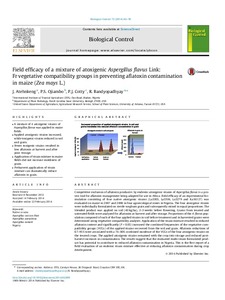| dc.contributor.author | Atehnkeng, J. |
| dc.contributor.author | Ojiambo, P. |
| dc.contributor.author | Cotty, P. |
| dc.contributor.author | Bandyopadhyay, Ranajit |
| dc.date.accessioned | 2019-12-04T10:58:25Z |
| dc.date.available | 2019-12-04T10:58:25Z |
| dc.date.issued | 2014 |
| dc.identifier.citation | Atehnkeng, J., Ojiambo, P., Cotty, P. & Bandyopadhyay, R. (2014). Field efficacy of a mixture of atoxigenic Aspergillus flavus Link: fr vegetative compatibility groups in preventing aflatoxin contamination in maize (Zea mays L.). Biological Control, 72, 62-70. |
| dc.identifier.issn | 1049-9644 |
| dc.identifier.uri | https://hdl.handle.net/20.500.12478/986 |
| dc.description.abstract | ompetitive exclusion of aflatoxin producers by endemic atoxigenic strains of Aspergillus flavus is a proventool for aflatoxin management being adapted for use in Africa. Field efficacy of an experimental formulationconsisting of four native atoxigenic strains (La3303, La3304, La3279 and Ka16127) wasevaluated on maize in 2007 and 2008 in four agroecological zones in Nigeria. The four atoxigenic strainswere individually formulated on sterile sorghum grain and subsequently mixed in equal proportions. Theblended product was applied on soil (40 kg/ha), 2–3 weeks before flowering. Grains from treated anduntreated fields were analyzed for aflatoxins at harvest and after storage. Proportions of the A. flavus populationcomposed of each of the four applied strains in soil before treatment and in harvested grains weredetermined using vegetative compatibility analyses. Application of the strain mixture resulted in reducedaflatoxin content and significantly (P < 0.05) increased the combined frequencies of the vegetative compatibilitygroups (VCGs) of the applied strains recovered from the soil and grain. Aflatoxin reductions of67–95% were associated with a 74–80% combined incidence of the VCGs of the four atoxigenic strains onthe treated crops. The applied atoxigenic strains remained with the crop into storage and reduced postharvestincreases in contamination. The results suggest that the evaluated multi-strain formulated producthas potential to contribute to reduced aflatoxin contamination in Nigeria. This is the first report of afield evaluation of an endemic strain mixture effective at reducing aflatoxin contamination during cropdevelopment. |
| dc.format.extent | 62-70 |
| dc.language.iso | en |
| dc.subject | Aspergillus Parasiticus |
| dc.subject | Aspergillus Flavus |
| dc.subject | Contamination |
| dc.subject | Maize |
| dc.title | Field efficacy of a mixture of atoxigenic Aspergillus flavus Link: Fr vegetative compatibility groups in preventing aflatoxin contamination in maize (Zea mays L.) |
| dc.type | Journal Article |
| dc.description.version | Peer Review |
| cg.contributor.crp | Maize |
| cg.contributor.affiliation | International Institute of Tropical Agriculture |
| cg.contributor.affiliation | North Carolina State University |
| cg.contributor.affiliation | University of Arizona |
| cg.coverage.region | Africa South Of Sahara |
| cg.coverage.country | Nigeria |
| cg.isijournal | ISI Journal |
| cg.authorship.types | CGIAR and advanced research institute |
| cg.iitasubject | Maize |
| cg.journal | Biological Control |
| cg.howpublished | Formally Published |
| cg.accessibilitystatus | Limited Access |
| local.dspaceid | 77915 |
| cg.identifier.doi | https://dx.doi.org/10.1016/j.biocontrol.2014.02.009 |

